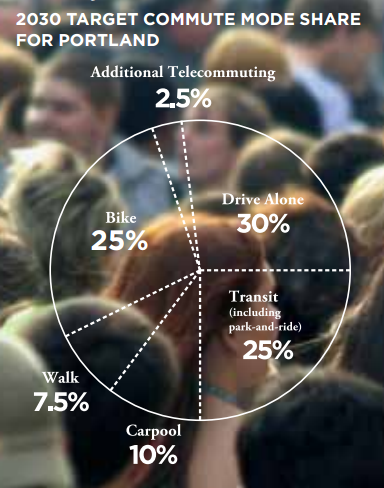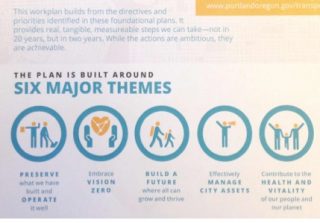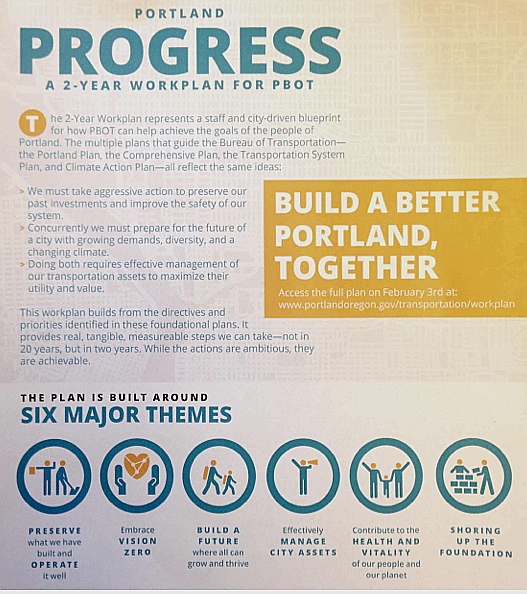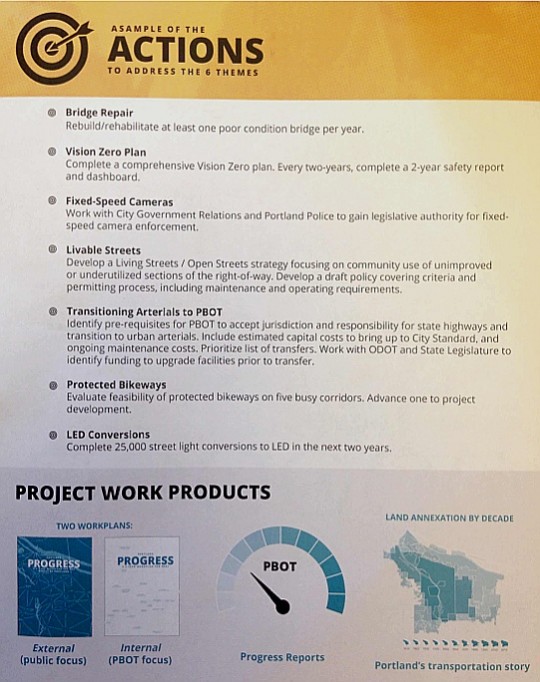Yesterday, we quoted the City of Portland’s transportation director about two of her most important policy goals for 2015. But her third goal for the year is far broader: to give the department, for the first time in years, a specific short-term to-do list.
The 170-item list, prepared with the help of consulting firm Nelson\Nygaard, aspires to cover everything the city’s 700-person transportation bureau is up to in the next two years.
The full list will be released on Feb. 3, the city says. But at Director Leah Treat’s speech on Tuesday to the transportation professionals’ group WTS, the city circulated this two-page summary including seven goals from the new plan:
Vision Zero Plan: Complete a comprehensive Vision Zero plan. Every two years, complete a two-year safety report and dashboard.
Protected bikeways: Evaluate feasibility of protected bikeways on five busy corridors. Advance one to project development.
Fixed speed cameras: Work with city Government Relations and Portland Police to gain legislative authority for fixed speed camera enforcement.
Livable Streets: Develop a Living Streets/Open Streets strategy focusing on community use of unimproved or underutilized sections of the right-of-way. Develop a draft policy covering criteria and permitting process, including maintenance and operating requirements.
Transitioning arterials to PBOT: Identify pre-requisites for PBOT to accept jurisdiction and responsibility for state higwhays and transition to urban arterials. Include estimated capital costs to bring up to city standard, and ongoing maintenance costs. Prioritize list of transfers. Work with ODOT and state legislature to identify funding to upgrade facilities prior to transfer.
Advertisement
Bridge repair: Rebuild/rehabilitate at least one poor condition bridge per year.
LED conversions: Complete 25,000 street light conversions to LED in the next two years.

targets of the city’s landmark 2009 Climate Action Plan.
(Image: Bureau of Planning and Sustainability)
On the longer scale, the plan aims for 70 percent of Portlanders to walk, bike, take mass transit, carpool or telecommute to work by 2030. That’d be up from about 30 percent today, a massive turnaround that would reduce drive-alone rates within Portland to those that New York City has today. The goal, which includes a goal of 25 percent of commutes by bike, was first set by the city’s 2009 Climate Action Plan and continues to be included in recent drafts of the 2015 Climate Action Plan update.
PBOT’s new two-year work plan, however, also sets out to divide the bureau’s work into smaller and more clearly achievable goals. It was one of Treat’s first major initiatives after coming into office in 2013 and has been in the works for nearly a year.
She said Tuesday that the plan is written so it can continue to be used as a reference and resource, and presumably to be updated periodically.
The city’s execution of the two-year plan will include regular progress reports on each goal. The document will be divided into one work plan aimed for internal use and another for public consumption; a draft version of the plan is already available on PBOT’s internal computers.
In addition, Treat said the city will unveil a section of its public website displaying “performance dials” (a.k.a. a dashboard) showing the city’s progress toward each of its goals.
“We’re going to lift the curtain,” Treat said Tuesday.




